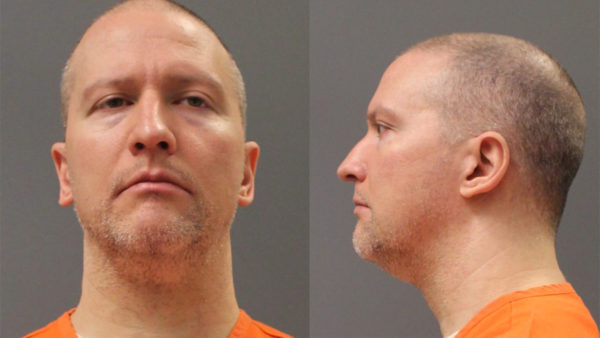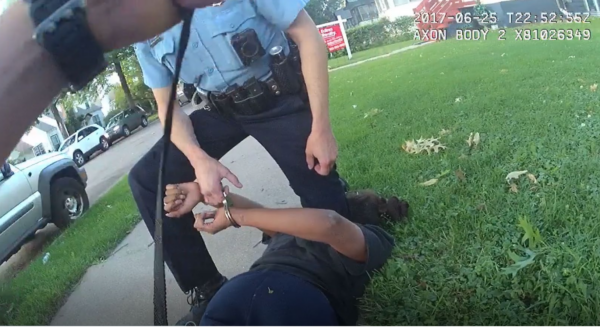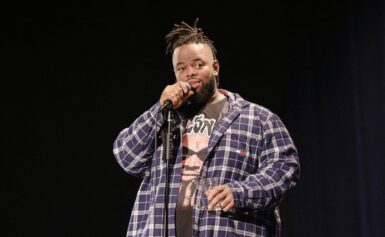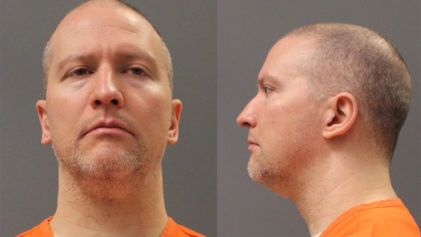A Minnesota teenager and woman have filed separate lawsuits against Derek Chauvin, claiming that had he been punished for their violent arrests five years ago, George Floyd may still be alive.
According to the lawsuits filed in federal court Tuesday, Chauvin was a “serial predator” who used “dangerous restraints” on Black people. If the Minneapolis Police Department had disciplined Chauvin, he would not be “left free to prowl for more Black persons to subjugate and torture,” the court documents said.

“George Floyd would be standing here today,” said John Pope, a teenager who was allegedly subjected to Chauvin’s “signature move.”
Pope is suing Chauvin and six other Minneapolis police officers for undisclosed damages for using excessive force when they arrested him in September 2017.
He alleges that Chauvin lashed him in the head repeatedly with a metal flashlight, grabbed him by the throat and pinned him against the wall, placed him in a chokehold and forced him to the ground with his knee for more than 15 minutes while he was handcuffed. Pope was 14 years old at the time.
Zoya Code, 39, said she was also abused by Chauvin and another officer during her June 2017 arrest. Chauvin once again held his knee into Code’s neck. In Code’s case, it was for four minutes and 41 seconds. She also wants to be compensated for the harm caused to her by the officers with excessive force.
“I didn’t know his name. All I knew was he was a police officer with Minneapolis Police Department,” she said. “I didn’t know what precinct he was at. All I knew was his face. [Chauvin] haunted me until I seen him on top of George.”
The court documents lay out the department’s history of police brutality dating back to the 1980s. According to a 72-page report published last month, MPD has a track record of disproportionately using excessive force against Black residents. Pope and Code’s lawsuit also alleges that the city knew that MPD officers were using deadly and harmful restraints on Black Minneapolitans.
“Rather than deal with the problem, the City – through a variety of bodies including the City Council, the Mayor, the City Attorney’s Office, and a number of faux police “oversight” boards – enables MPD to the detriment of its citizens, who are the subjects of unconstitutional force practices, and its taxpayers foot the bill,” attorney Bob Bennett wrote.
Body-worn camera footage of Chauvin’s interactions with Pope and Code was available to his supervisors through an electronic storage portal. “But the city buried its head in the sand regarding such evidence or even worse, reviewed it and did nothing, in either case continuing to condone such actions by officers,” the complaint alleges.
Bennett said it was miraculous that Chauvin had not killed anyone else before Floyd.
In May 2020, Chauvin pressed his knee into Floyd’s neck for nearly nine minutes as bystanders begged him to stop. The deadly arrest was captured on video that immediately went viral, sparking an international outcry against racial inequality in policing and excessive force. Chauvin was convicted and sentenced to more than 22 years in prison for Floyd’s murder. He pleaded guilty to federal civil violation charges in December as well and is awaiting sentencing.
Chauvin joined the MPD in 2001. According to court documents, he had at least 16 civilian complaints against him by the time he arrested Code on June 25, 2017. They led to just two letters of reprimand.
In November 2013, Chauvin and other officers dragged a Black mental-health worker from his car during a traffic stop and slammed him to the ground, kneed him in the neck and back while he was in the prone positon. In 2005, Chauvin was involved in a police chase that resulted in three deaths, court documents say.
Chauvin was never disciplined for the two incidents. Instead, he was appointed a field-training officer.
Code suffered from a mental illness. Chauvin and MPD officer Ross Blair had responded to a report from Code’s mother that her daughter had strangled her with an extension cord. When Chauvin arrived at Code’s home, he spun her around and handcuffed her after a “brief struggle,” court documents allege.

The lawsuit alleges that Code complied with the officers’ orders.
“I’m resisting?” Code said.
“No. You’re not,” one of the officers said.
After dragging Code outside, Chauvin slammed the woman’s head on the ground before taking his “signature pose.”
“How long are we gonna stay like this? Can you get off my neck?” Code asked.
“Push harder,” she said. “That’s how they kill Black people in America.”
Chauvin and his partner Alexander Walls also responded to a domestic assault call at Pope’s home on Sept. 4, 2017. Pope’s mother, Deanna Jenkins, who reportedly appeared drunk, told the officers she wanted her children removed from the house.
Jenkins told officers that Pope grabbed her “and just started wrestling me or whatever” after she took the teenagers’ cell phone chargers away. John’s sister, Krystal Pope, was 16 years old and pregnant at the time.
Pope was in his room when the officers walked up to the doorway.
“John, why don’t you come out here?” Walls said, but the lawsuit alleges that Pope did not get a chance to comply because the officer and his mother walked into the room.
Walls told the teenager that he was under arrest. Pope argued, however, that his mother was drunk, and she was the one who assaulted him. He told the officers to confirm the story with his sister, but they ignored his comments and ordered him to stand up two more times before he complied.
As Walls grabbed Pope’s hand to arrest him, Chauvin ran from the doorway and started slamming the flashlight into Pope’s head. Chauvin struck Pope so hard that his body-worn camera fell off of his uniform at one point. After pinning Pope to the wall, the officers forced him to the floor, where Chauvin bashed him again with the large flashlight.
According to court documents, Jenkins reminded the officers that Pope was only 14 years old, and she begged them not to kill her son four times.
“Chauvin knew from his training and experience as an MPD officer that striking someone in the head with a flashlight was the use of deadly force,” the complaint says.

Over the 15 minutes that Chauvin kneed Pope, the teenaged boy cried that he could not breathe. His mother pleaded with the officer to remove his knee eight times, court documents show. The boy was bleeding from the ear and required two stitches. Chauvin pleaded not guilty to violating Pope’s right to be free of unreasonable force in September.
Eight other officers responded to the family’s home and saw Chauvin’s knee on the boy’s neck, but none intervened.
The five other officers named in the lawsuit are Joshua Domek, David Nerling, Graham Plys, David Robins and Sgt. Lucas Peterson. Walls, Domek and Nerling are still with the MPD.
Minneapolis City Attorney Peter Ginder called the Pope and Code incidents “disturbing.”
“We intend to move forward in negotiations with the plaintiffs on these two matters and hope we can reach a reasonable settlement,” Ginder said in a statement. “If a settlement cannot be reached on one or both lawsuits, the disputes will have to be resolved through the normal course of litigation.”
Former Minneapolis police inspector Catherine Johnson said she was never told about Chauvin’s incidents with Pope and Code, adding that his immediate supervisors approved of his conduct during arrests.
“I think time after time a lot of police officers forget that they’re a mediator, and that they see people on their worst days, not their best, and that they’re calling you to help, not to make it worse,” Pope said.


